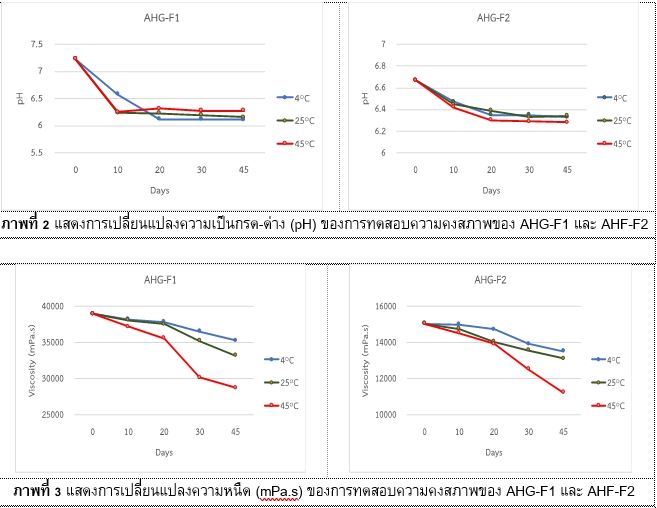Aloe vera leaf extract by glycerin: tyrosinase enzyme inhibitor and cosmetic formulations
Keywords:
Aloe vera, Glycerin, Tyrosinase enzyme inhibitor, CosmeticsAbstract
Aloe vera is an economic plant of Prachuap Khiri Khan Province and a popular herb added to cosmetic formulas due to its skin-soothing properties. However, the high price of Aloe vera extract in the market makes high production costs for small and medium-sized community enterprises. This research developed a method for extracting fresh Aloe vera gel with glycerin. Various concentration of 20-80% glycerin solution was used for fresh Aloe vera gel extraction. The solution was dried, and the anti-tyrosinase enzyme efficacy was tasted. The fresh Aloe vera gel-glycerin extract showed a percentage of tyrosinase enzyme inhibition between 38.72- 42.05. The extract derived from 80% glycerin solution as solvent showed the highest level at 42.05% ± 1.35. In addition, when comparing the percentage of an anti-tyrosinase enzyme of the crude Aloe vera extract using the standard extraction method, it displayed the percentage of an anti-tyrosinase enzyme at 47.50 ± 1.98, which is similar to the extraction using glycerin. The data above developed an efficient and convenient method for fresh Aloe vera gel extraction. The fresh Aloe vera gel and 80% glycerin solution were blended (1:1) with a multi-purpose blender and filtrated with white fabric. The filtrated solution was used in cosmetic formulations. In this research, two cosmetic formulas, Aloe vera body spa (ABS) and Aloe vera hydrating gel (AHG), were developed using fresh Aloe vera gel-glycerin extract as an ingredient from 0-50 percent by weight in each recipe. After formulating, the compatibility of fresh Aloe vera gel-glycerin extract in cosmetic products was examined by observing the layer separation. It was found that the fresh Aloe vera gel-glycerin extract exhibited good compatibility with cosmetic product formulations. In addition, the stability test of cosmetic products was examined. Interestingly, products containing fresh Aloe vera gel-glycerin extract also showed good stability. The maximum amounts of fresh Aloe vera gel-glycerin extract added to both cosmetic formulations (ABS and AHG) were 5% and 10%, respectively.
References
Bown D. Enclycopedia of herbs and their uses. NSW: RD Press; 1995. 424 p.
Surjushe A, Vasani R, Saple DG. Aloe vera: A short review. Indian Journal of Dermatology. 2008;53(4):163-166.
World Health Organization. WHO monographs on selected medicinal plants. Vol. 1. Geneva: Matta; 1999. 295 p.
Biudreau MD, Beland FA. An evaluation of the biological and toxicological properties of Aloe barbadensis (Miller), Aloe vera. 2006;24(1):103-154.
Bilton CL. Vitamin containing skin care ointment. PCT Int Appl WO 402,845. 1983. 14 p.
Lion C. Cosmetics containing vitamin E analogs and Aloe extracts for skin cracking control. Patent: Jpn Kokai Tokkyo Koho JP 59 16,816 [84 16,816]. 1984. 12 p.
Nowak GA. Substances for skin and hair care. Parfum Kosmet. 1986;67(2):80-90.
Ivan FD. Potential Reversal of chronological and Photo-aging of the skin by topical application of natural substances. Phytother Res. 1993;7:s53-s56.
Labowe II. Topical compositions for decreasing wrinkles and smoothing skin. U S US 4,474,763 1984. 4 p.
Faider AF. Antiwrinkle cream containing snake oil and aloe extract. Fr Demande FR 2,750,324, 1998. 4 p.
Lion C. Cosmetics containing aloin. Patent: Jpn Kokai Tokkyo Koho 80,145,607. 1980. 4 p.
Ando H, Asano T, Thuchiya N. Cosmetics for skin care. Japan 77 44,375, 1977. 5 p.
Meadow T. Formulating cosmetic with aloe vera. Drug and Cosmetic Industry. 1983;32(2):34-40.
Ramachandra CT, Rao PS. Processing of Aloe vera leaf gel: A review. Am J Agric Biol Sci. 2008;3(2):502-510.
Oliveira BPP, Rodrigues F. Plant Extracts in Skin Care Products. MDPI: Switzerland; 2018. 144 p.
Becker LC, Bergfeld WF, Belsito DV, Hill RA, Klaassen CD, Liebler DC, et al. Safety assessment of glycerin as used in cosmetics. Int J Toxicol. 2019;28(3):6S-22S.
Shehata E, Grigorakis S, Loupassaki S, Makris DP. Extraction optimization using water/glycerol for the efficient recovery of polyphenolic antioxidants from two Artemisia species. Sep Purif Technol. 2015;149:462–469.
Erpel F, Mariotti-Celis MS, Parada J, Pedreschi F, Pérez-Correa JR. Pressurized hot liquid extraction with 15% v/v glycerol-water as an effective environment-friendly process to obtain Durvillaea incurvata and Lessonia spicata phlorotannin extracts with antioxidant and antihyperglycemic potential. Antioxidants. 2021;10(7):1105.
Jabłonowska M, Ciganović P, Jablan J, Marguí E, Tomczyk M, Zovko Končić M. Silybum marianum glycerol extraction for the preparation of high-value anti-ageing extracts. Ind Crops Prod. 2021;168:113613.
Hu Y, Xu J, Hu Q. Evaluation of antioxidant potential of Aloe vera (Aloe barbadensis Miller) extracts. J Agric Food Chem. 2003;51(26):7788–7791.
Yu LL, Hu WC, Ding G, Li RT, Wei JH, Zou ZM, et al. Gusanlungionosides A-D, potential tyrosinase inhibitors from Arcangelisia gusanlung. J Nat Prod. 2011;74(5):1009-1014.
Thai Industrial Standards Institute. Skin care product. Tis no. 478-2555. 2012.
Nuanyai T. Mixed herbs shower gel for community products. ABC Journal. 2016;8(1):42–61.

Downloads
Published
How to Cite
Issue
Section
License
Copyright (c) 2022 Naresuan Phayao Journal

This work is licensed under a Creative Commons Attribution-NonCommercial-NoDerivatives 4.0 International License.
ผู้นิพนธ์ต้องรับผิดชอบข้อความในบทนิพนธ์ของตน มหาวิทยาลัยพะเยาไม่จำเป็นต้องเห็นด้วยกับบทความที่ตีพิมพ์เสมอไป ผู้สนใจสามารถคัดลอก และนำไปใช้ได้ แต่จะต้องขออนุมัติเจ้าของ และได้รับการอนุมัติเป็นลายลักษณ์อักษรก่อน พร้อมกับมีการอ้างอิงและกล่าวคำขอบคุณให้ถูกต้องด้วย
The authors are themselves responsible for their contents. Signed articles may not always reflect the opinion of University of Phayao. The articles can be reproduced and reprinted, provided that permission is given by the authors and acknowledgement must be given.







